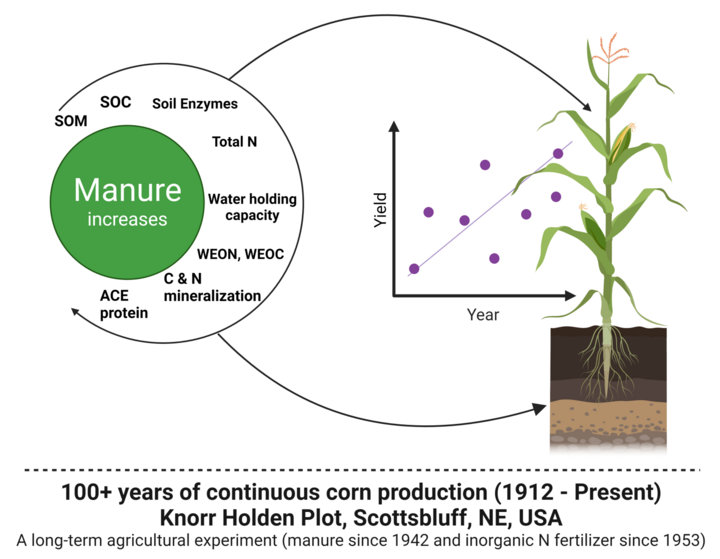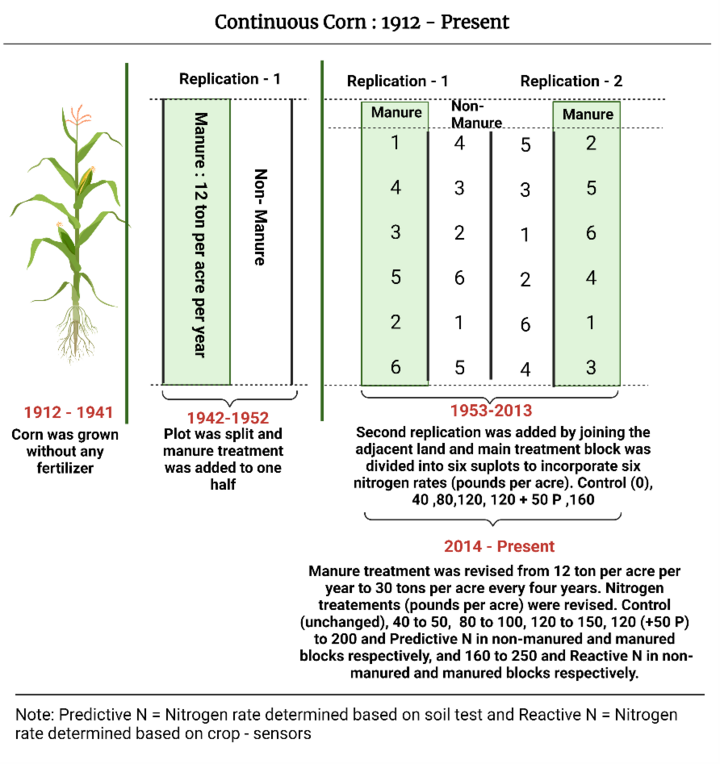Manure Improves Soil Health and Provides Yield Stability and Reliability

The Knorr-Holden (KH) plot is the oldest experimental irrigated corn plot in North America, established in 1910. Since 1912, the plot has been continuously planted with corn, and until 1941, no amendments or treatments were carried out. In 1942, the plot was divided to include beef cattle manure (at 12 tons per ac) treatment, and in 1953, a split-plot design was introduced with manure treatment as the main factor and inorganic fertilizer N treatment as a subplot (Figure 1). In 2014, the treatments were revised to reflect contemporary agronomic practices, including the development of precision agricultural tools (Figure 1).

Soil organic matter and carbon
Over a period of 77 years of applying manure to soil:
- Soil organic carbon (SOC) increased by more than 60% (to 1.4%) from non-manure plot (0.8%)
- Soil organic matter (SOM) increased by more than 60% (to 2.7%) compared to the non-manured plot at (1.6%).
- Water-extractable organic carbon (WEOC) and active carbon (AC or POXC) were increased.
- Plant-available water content increased by 6.94% compared to the non-manured plot.
Soil nitrogen and phosphorus fractions
- Manure application can increase nitrogen mineralization and nitrification, leading to improved soil fertility and plant growth.
- The manured plots had higher concentrations of NO3-N, indicating a higher rate of nitrification, and lower concentrations of NH4-N compared to non-manured plots.
- Manured plots showed higher concentrations of ACE protein, water-extractable nitrogen (WEN), water-extractable organic nitrogen (WEON), and potentially mineralizable nitrogen (PMN), suggesting an increase in microbial activity and nitrogen mineralization.
- Long-term manure application can significantly increase all measured P fractions, which may increase the susceptibility of P losses via leaching.
Soil enzymes
- Soil enzymes are a valuable indicator of soil health, responding to various soil factors such as temperature, moisture, and nutrient availability.
- At the Knorr-Holden plot, manure application resulted in a significant increase in all four tested soil enzymes: β-glucosidase, Arylsulfatase, N-acetyl-glucosaminidase, and Alkaline Phosphomonoesterase.
- This increase in soil enzymes indicates a positive effect on soil health due to manure application.
Yield Stability and Reliability
- In the Knorr-Holden plot, there was a decline in grain yield over time (1912-1941) until manure application was introduced in 1942.
- Corn grain yields in the manured plot linearly increased in the first decade since manuring began (1942-1952).
- Corn yields did not vary significantly with or without inorganic N in the manured plots, indicating potential economic and environmental disadvantages to supplementing manure with inorganic N fertilizer unnecessarily.
- Non-manured nutrient-depleted soil always showed a positive correlation between inorganic N rates and grain yield.
- Long-term application of manure can enhance yield stability and reliability, with the manured plot supplemented with N and P having the highest yield reliability index.
- Actual crop N requirement should be considered when planning the use of manure and inorganic fertilizer as in high C systems such as manure inorganic N content can be immobilized, and crop nutrient needs may not always be met with manure alone.
To summarize, using manure in corn production improved yield stability and soil health by increasing organic matter and nutrients, as well as improving water holding capacity and soil enzyme activity. However, to achieve a sustainable and reliable yield, it is important to optimize the use of both manure and inorganic fertilizer nutrients. Manure plot with supplemental N and P showed the highest yield reliability.
This article was reviewed by Leslie Johnson and Agnes Kurtzhals.